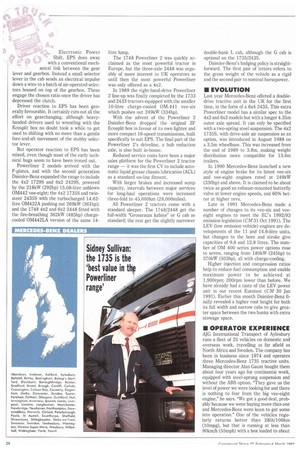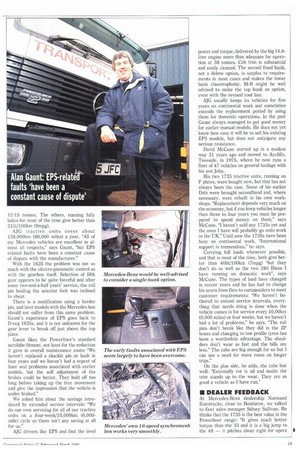4 0. Electronic Power • - c• 11.•• — ' 11 ' Shift. EPS does away
Page 30

Page 31

If you've noticed an error in this article please click here to report it so we can fix it.
P e1,0 %.# with a conventional mechanical link between the gear lever and gearbox. Instead a small selector lever in the cab sends an electrical impulse down a wire to a batch of air-operated selectors housed on top of the gearbox. These engage the chosen ratio once the driver has depressed the clutch.
Driver reaction to EPS has been generally favourable. It certainly cuts out all the effort on gearchanging, although heavyhanded drivers used to wrestling with the Ecosplit box no doubt took a while to get used to shifting with no more than a gentle fore-and-aft movement of the stubby selector lever.
But operator reaction to EPS has been mixed, even though most of the early technical bugs seem to have been ironed out.
Powerliner 2 models arrived with the F-plates, and with the second generation Daimler-Benz expanded the range to include the 4x2 17295 and 6x2 2429S, powered by the 218kW (292hp) 15.08-litre unblown 0M442 vee-eight; the 4x2 1735S and twinsteer 24355 with the turbocharged 14.62litre 0M422A pushing out 269kW (361hp); and the 1748 4x2 and 6x2 2448 fitted with the fire-breathing 362kW (485hp) chargecooled 0M442LA version of the same 14 The 1748 Powerliner 2 was quickly acclaimed as the most powerful tractor in Europe, but the three-axle 2448 was arguably of more interest to UK operators as until then the most powerful Powerliner was only offered as a 4x2.
In 1989 the right-hand-drive Powerliner 2 line-up was finally completed by the 1733 and 2433 tractors equipped with the smaller 10-litre charge-cooled OM.441 vee-six which pushes out 249kW (334hp).
With the advent of the Powerliner 2 Daimler-Benz dropped the original a Ecosplit box in favour of its own lighter and more compact 16-speed transmissions, built specifically to suit EPS, The final part of the Powerliner 2's driveline, a hub reduction axle, is also built in-house,
Reduced service costs have been a major sales platform for the Powerliner 2 tractor range — it was the first CV to include automatic liquid grease chassis lubrication (ACL) as a standard on-line fitment.
With larger brakes and increased sump capacity, intervals between major services for long-haul operations were increased three-fold to 45,000km (28,000miles).
All Powerliner 2 tractors come with a standard sleeper. The 1748/2448 get the full-width "Grossraum kabine" or G cab as standard; the rest get the slightly narrower double-bunk L cab, although the G cab is optional on the 1735/2435.
Daimler-Benz's badging policy is straightforward. The first pair of letters refers to the gross weight of the vehicle as a rigid and the second pair to nominal horsepower.
Last year Mercedes-Benz offered a doubledrive tractive unit in the UK for the first time, in the form of a 6x4 2435. This extra Powerliner model has a similar spec to the 4x2 and 6x2 models but with a longer 4.35m outer axle spread. It can only be specified with a two-spring steel suspension. The 4x2 1735S, with drive-axle air suspension as an option, was introduced in August 1988 on a 3.5m wheelbase. This was increased from the end of 1989 to 3.8m, making weight distribution more compatible for 13.6m trailers.
In 1990 Mercedes-Benz launched a new style of engine brake for its latest vee-six and vee-eight engines rated at 249kW (330hp) and above. It is claimed to be about twice as good an exhaust-mounted butterfly valve at lower engine speeds, and 60% better at higher revs.
Late in 1991 Mercedes-Benz made a number of changes to its vee-six and veeeight engines to meet the EC's 1992/93 emission legislation (CM 31 Oct 1991). The LEV (low emission vehicle) engines are developments of the 11 and 14.6-litre units, but changes to the bore and stroke give capacities of 9.6 and 12.8 litres. The number of OM 400 series power options rose to seven, ranging from 180kW (245hp) to 370kW (503hp), all with charge-cooling.
Higher injection and compression ratios help to reduce fuel consumption and enable maximum power to be achieved at 1,900rpm; 200rpm lower than before. We have already had a taste of the LEY power unit in our recent Eurotest (CM 30 Jan 1991). Earlier this month Daimler-Benz finally revealed a higher roof height for both its full width and narrow cabs to give greater space between the two bunks with extra stowage space.
AJG International Transport of Aylesbury runs a fleet of 25 vehicles on domestic and overseas work, travelling as far afield as North Africa and Sweden. The company has been in business since 1974 and operates three Mercedes-Benz 1735 tractive units. Managing director Alan Gaunt bought them about four years ago for continental work, equipped with steel-sprung suspension and without the ABS option. "They gave us the level of power we were looking for and there is nothing to fear from the big vee-eight engine," he says. "We got a good deal, probably because we were buying more than one and Mercedes-Benz were keen to get some into operation." One of the vehicles regularly returns better than 2811t/100km (10mpg), but that is running at less than 90km/h (55mph) with a box loaded to about 12-15 tonnes. The others, running fully laden for most of the time give better than 311it/100km (9mpg).
AJG tractive units cover about 128,000km (80,000 miles) a year. "All of my Mercedes vehicles are excellent in almost all respects," says Gaunt, "but EPS related faults have been a constant cause of dispute with the manufacturer."
With the 1635 the problem was not so much with the electro-pneumatic control as with the gearbox itself. Selection of fifth gear appears to be quite forceful and after some two-and-a-half years' service, the roll pin holding the selector fork was inclined to shear.
There is a modification using a harder pin, and later models with the Mercedes box should not suffer from this same problem. Gaunt's experience of EPS goes back to D-reg 1635s, and it is not unknown for the gear lever to break off just above the top plate.
Gaunt likes the Powerliner's standard autolube fitment, not least for the reduction it gave in overall maintenance costs: We haven't replaced a shackle pin or bush in four years and we haven't had a repeat of liner seal problems associated with earlier models, but the self adjustment of the brakes could be better. They hold off too long before taking up the free movement and give the impression that the vehicle is under braked."
We asked him about the savings introduced by extended service intervals: "We do our own servicing for all of our tractive units on a four-week/10,000km (6,000mile) cycle so there isn't any saving at all for us."
AJG drivers like EPS and find the level power and torque, delivered by the big 14.6litre engine more than adequate for operation at 38 tonnes. Cab trim is substantial and easily cleaned. The second fixed bunk, not a delete option, is surplus to requirements in most cases and makes the lower bunk claustrophobic. M-B might be well advised to make the top bunk an option, even with the revised roof line.
AJG usually keeps its vehicles for five years on continental work and sometimes extends the replacement period by using them for domestic operations. In the past Gaunt always managed to get good money for earlier manual models. He does not yet know how easy it will be to sell his existing EPS models, but does not anticipate any serious resistance.
David McCune started up in a modest way 31 years ago and moved to Aycliffe, Teesside, in 1975, where he now runs a fleet of 47 vehicles on general haulage with his son John.
His two 1735 tractive units, running on F plates, were bought new, but that has not always been the case. Some of his earlier Dafs were brought secondhand and, where necessary, were rebuilt in his own workshops. "Replacement depends very much on the economy, but if you keep vehicles longer than three to four years you must be prepared to spend money on them," says McCune. "I haven't sold any 1735s yet and the ones I have will probably go onto work in the UK." Until now the 1735s have been busy on continental work. "International support is tremendous," he says.
Carrying full loads whenever possible, and that is most of the time, both give better than 4011t/100km (7mpg) "but they don't do as well as the two 280 Hinos I have running on domestic work', says McCune. The types of load have changed in recent years and he has had to change his semis from flats to curtainsiders to meet customer requirements: "We haven't bothered to extend service intervals, everything that needs doing is done when the vehicle comes in for service every 10,00km (6,000 miles) or four weeks, but we haven't had a lot of problems," he says. "The roll pins don't break like they did in the ZF boxes and changing to low profile tyres has been a worthwhile advantage. The shoulders don't wear as fast and the bills are less." The cabs are big enough for us but I can see a need for more room on longer trips."
On the plus side, he adds, the cabs last well: "Externally rot is nil and inside the trim stands up to the wear. They are as good a vehicle as I have run."




















































































